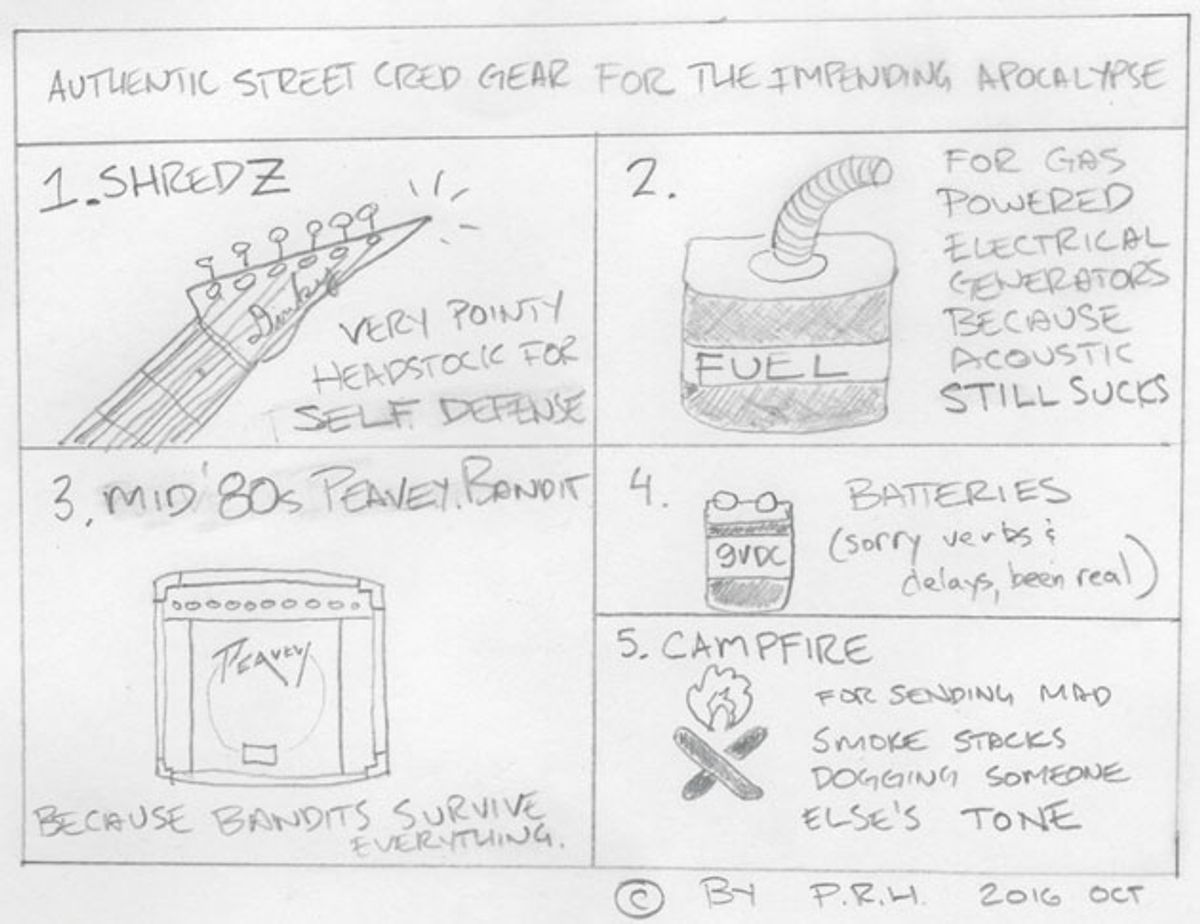
Breaking with routine can be the best way to make real trouble and noise. Do it!
You thought you could be more authentic by stripping it down. That makes sense. You’ve unplugged from all that gear, sat down with an acoustic guitar, and you’ve decided you’re going to get raw and real. But everything in that guitar has an effect on your sound and playing. The bracing dictates how it projects. The choice in top wood prescribes how it responds to your picking style. The shape of the neck will have a say in what chords or patterns you try to pull off. Even the depth of the body will change how you hold the instrument and decisions you’ll make while playing.
So you’ve decided that you’ll give in a little bit and just go guitar to amp. The pickup you select might be strident or soothing. The volume and tone controls create different low-pass filters that attenuate highs even when dimed. The bridge saddle material affects the presence, while the body wood affects the resonance. Even the weight of the tuners has an effect. Some guitars just make you play a certain way.
The long and the short. No matter who markets the nonsense, there is no such thing as a perfectly transparent guitar cable. There’s capacitance per foot, inductance, and the conductive material and plating of the connectors. The length makes a huge difference, as does the shape. A coiled cable can have as much of an effect on your tone as turning the knob or changing the capacitor on your guitar’s tone control. You may find too much length seems to weigh your signal down; too little makes it feel a bit too sharp.
Your amp has all kinds of magical frequency and response massaging going on. I’ll let another PG contributor walk you through all that. But a purportedly transparent amplifier would sound awful. As part of an ecosystem and signal chain, your guitar pickups can be marvels. But the honest sound of the AC current your high-impedance source generates through a purportedly transparent reproduction system is often an unforgiving, anemic affair.
Maybe you’ve decided to just go back to older drive pedals. I love them, too. But with their distinct personalities, the analog world of EQ and filtering has its own drawbacks. If there’s no tone control, the designer basically decided what it would be for you. If there is one, either somebody at a breadboard with a scope decided where those frequency corners might be, or somebody looked at a pile of parts collecting dust in inventory and said, “We better get rid of these.” Surprisingly, both can work.
Everything is an effect. The sounds of distorted guitar amplifiers, once a signifier for danger, volume, and upsetting the polite order of the world, can now simply be summoned as easily as a keyboard patch to simulate a marimba. The most vanilla, corporate, lukewarm, milquetoast, harmless “musical product” released upon the public can have square waves that Roger Mayer or Jimi Hendrix could only have dreamed of. The most fearsome tones of amplifier crunch regularly play in the background of professional sports highlights. To simply present these sounds as proof of your opposition to a world you find oppressive or your desire to simply watch it burn is no longer enough.
There have been countless salesmen throughout history who have promised whatever player pianos, phonographs, and “high fidelity” devices they hawked would signify the end of live music performance. I’ve been told of the end of effects pedals and guitar amplification countless times over the last 30 years of appreciating and playing music. My friends who play keys—the instruments best technologically equipped for recapturing the essence of other instruments—mock this notion outright even as they use these tools: “Do you really think I can dial up a grand piano, and some cheesy amplifier and speaker is really going to totally replace the experience of hearing 800 pounds of ebony, spruce, copper, and steel?” They understand that no matter how good the simulation gets, it’s a simulation, a placeholder, a substitute. It’s just an effect.
I was recently shown a video of Pete Rose talking about hitting a baseball. Controversial as he is, he did it successfully over 4,000 times at the highest level of the sport. I loved how he spoke about trying simple adjustments to shake out of a slump or a lull. Move up in the box, move back in the box, move in on the plate, move out on the plate, choke up on the bat, move down on the bat. It’s absolutely brilliant, simple advice. Change something up. Try a different pedal. Plug into a different amp. Pull a different pick size from the jar. Grab a different guitar. Play it “straight” with just an acoustic guitar. Go “out” with stuff dialed beyond its normal operating range and see what happens. Roll off some highs with that funky cable. Go brighter with a different pickup choice. Everything is an effect, and has an effect. Use them to help you make some real trouble and noise in this world.
